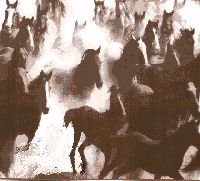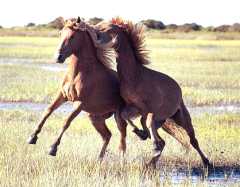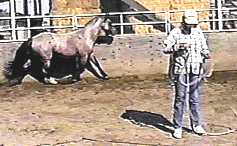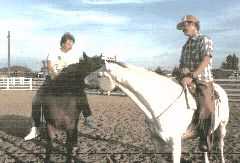Dominance-to-Flight Ratio
|

|
|
Horses will generally respond to stress or stimulation in one
of two ways. They will either attempt to assert dominance over
a situation, such as when another horse (or animal) disturbs or
upsets them, or they will take flight. Each individual horse
will display some level of dominance and flight characteristics.
How this behavior is exhibited depends on the horse's horsenality
and learned experiences. Different stimuli may also prompt differences
in a horse's response, with the horse challinging one situation while
making an immediate and hasty retreat in another.
Since we humans are number oriented, I have placed a numerical value on each horse's response to remind us as to what level of animal we are working and to better enable us to communicate with other humans about the horses we are collectively handling.
|
Some horses tend to dominate
| |||||||||||||||||
|
The numbers 1, 5 and 10 described above are merely waypoints and horses can be scored anywhere
in the range of 1 to 10. How you would assign a score to a horse is a judgement call based
on your observations of the horse's behavior and his/her response to stimuli.
For example, an alpha driven mare with low confidence may score out as a 5/9. She wants to be in control and may be very aggressive over the paddock fence, but when confronting another horse in the open where she may pay a price for her actions, she will beat a hasty retreat in response to the slightest provocation by the other horse. Another mare may have a very low flight response but also may not be assertively dominant so she scores low on both sides of the scale. This is the mare that doesn't look for trouble, but if challenged will generally stand her ground. The handler should always remember that a horse's response is based on both its genetic heritage and its experiences. Thus how a horse scores can be modified (improved or worsened) over time through the training methods employed and as the horse's confidence level improves or erodes. How you handle a particular horse should be guided in part by the horse's dominance / flight ratio. Furthermore, the way you handle that horse will likely have an effect on that horse's ratio in the future - a situation that in turn can make the horse easier or more difficult to work with as training progresses.
Continue to
|



